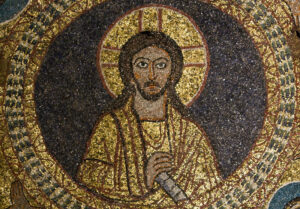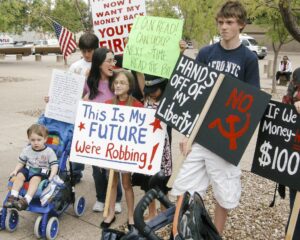Part of the critical brushback concerns violence in the film and the supposed possibility or perception that the film advocates or could serve as a pretext to civil violence. Critics sounded early warnings about violence, and connected that to the problem of mass shootings in the US. Some even invoked the Aurora, CO incident, which involved a mass shooting inside a movie theatre playing an earlier Batman franchise film. This kind of alarmism is warranted to some degree, notably when connected to a critique of US gun laws. But it is also unprecedented in terms of critical reaction to a piece of cinema. (Perhaps only Mel Gibson’s The Passion of the Christ was met with as many think pieces regarding its potential for inciting violence — and that due to its repristination of religiously rooted racial tropes).
At the same time, Joker marks the first time that a US film release has been accompanied by activation (!) of US military personnel due to a possible threat to public safety — a ‘homeland security risk’ posed by a film. Not even Martin Scorsese’s The Last Temptation of Christ involved mobilization of the US National Guard or military personnel, despite protestors, bomb threats, and several incidents in its European theatrical run. (More on Scorsese below). In ‘nesting doll’ fashion, over the weeks leading up to its US premier, critics highlighted how Joker plays to ‘incel’ fantasies and ideologies, seemingly encouraging and endorsing misogyny, sexual violence and intimidation. The ‘incel’ dimension, in fact, quickly became the predominant critical reading of the film.
A further controversy — not entirely unrelated to the incel charge — surfaced not long after. Scorsese, while promoting his most recent work, The Irishman, made off-the-cuff remarks about Marvel– and other comic book-based films, characterizing them as ‘amusement park’ entertainment rather than cinema, and expressed dissatisfaction at their outsize claim on exhibition space. The remarks sparked extensive responses to the filmmaker, especially after he repeated the claims at subsequent publicity events for his new film (not to mention the intrusion of 80-year-old film director, Francis Ford Coppola, into the controversy).
A few things are interesting about Scorsese’s involvement in this. First, most have focused exclusively on Scorsese’s portrayal of these movies as not being cinema, taking umbrage at this seeming dismissal.Scorsese may not be right in his assessment but he has, as Jon Favreau (himself an MCU director) recently asserted, more than earned the right to his perspective. Few, though, have looked more closely at the larger context or substance of Scorsese’s remarks, which have subtle, political shades. In particular, Scorsese’s chief target does not appear to be Marvel or comic book films at all, but rather the mechanisms of financing and distribution. The real intent behind Scorsese’s comments was to highlight the monopolization of film financing and distribution by a single cinematic type: hereby, Scorsese underscores how studios have become increasingly conservative in the kind of films they agree to back financially. It is interesting to note, in fact, the limitation of consumer choice in one of the most capitalist industries — something that Scorsese’s criticism brings to the foreground.
Scorsese’s remarks are interesting in another respect as well. On the one hand, it is now known that Scorsese himself was involved in the early development of Joker, even at one point being a possible director for the project. (Scorsese departed when it was clear to him that digital technology was now advanced enough to enable him to make The Irishman). It would not be in his financial interest, so to speak, to suppress the film. On the other hand, whether linked to Scorsese’s initial involvement in the early development of the project or not — and it appears to be not — Joker quite clearly is indebted to Scorsese’s canon, and more specifically seems to occupy cinematic space with Scorsese’s films Taxi Driver and King of Comedy.
This connects back to the oddity of the critical controversy around the film as supposedly being ‘incel cinema’: if anything, it is Scorsese’s films — Taxi Driver and King of Comedy in particular — that are incel revenge fantasies. This is not to disparage Scorsese’s work at all, but to reorient the critical discourse around interpretation of Joker. Scorsese’s films, especially Mean Streets, Taxi Driver, Raging Bull, and King of Comedy, are focused on characters who are not just isolated/alienated from the society around them, but become romantically — and delusionally — obsessed with a female object of interest, whose lack of reciprocity sends the male character into a tailspin and ultimately violent outburst.In fact, the violence in Scorsese’s early work might be characterized as a semi-hybrid cinematic exploration of “incel” violence incubated from within a seething, rotting cultural and political setting. The Scorsese films that are genealogically connected to Joker involve male characters who are not only alienated from society at large, but who are socially and romantically cut-off, and the anger that results from both situations compounds until it explodes in a cacophonous expression of impotent violence.
Joker is, nearly directly, a political reinterpretation of Scorsese’s films, transmogrifying the source material from (pre)incel character study to a political document of the tightly interwoven structural relationships between poverty, austerity, neoliberalism, mental illness, political revolution, class warfare, and liberation. The film is heavily indebted to Scorsese from cinematic themes, tropes, and story point to material history, most notably the physical and political space of malaise-era New York City and its enforced austerity environment. Yet it also rejects the sexual politics of the Scorsese films that are direct influences on it — including two scenes that are clearly hallucinations by Arthur (one of which is a recreation of a fantasy by Robert De Niro’s character in King of Comedy) — and not only concretely evacuates the uncomfortable social-sexual dynamics of the antecedent film, but subverts the heart of the ‘incel’ claim and sexual alarmism of critical evaluation of Joker.
What Phllips does in Joker is to use textures from Scorsese’s work to explore considerably important social and political realities and dynamics,doubly layered in an alternate origin mythology in the Batman universe. Joker’s Arthur Fleck walks the same streets as Scorsese’s Travis Bickle and Rupert Pupkin — all characters whose journeys are inseparable from the municipal stagnation that provides the films’ mise en scène. In Scorsese’s films, the fetidness of the city symbolizes and aggravates the alienation and dislocation of his characters. Phillips pushes this dynamic even further showing much more overtly the political dynamic that creates and furthers civil squalor. A significant part of the film portrays the character of Thomas Wayne, father of Bruce, as an überwealthy elite mayoral candidate running to protect the rich from ‘excessive taxation’ through the implementation of austerity politics, which degrades the public structures, services, and resources.
Arthur’s journey, as a man on the brink of poverty who suffers from a behavioral health condition and cares for an invalid parent, sharply illuminates the experience of those without means who must interface with a variety of institutions and services undergoing enforced austerity measures. The violence that lurks underneath the surface of the film is not about aggression in the face of unrequited romantic obsession, but the violence of a system that repeatedly fails, neglects, and penalizes its subjects and breeds a violent resentment in those that it dispossesses. The violence of the system itself, in fact, is one of the more shocking elements in Joker.
Arthur’s transformation into Joker, which borrows liberally from Rupert’s arc in Scorsese’s King of Comedy, is a violent revolt against that system and its brutality (and brutalizing isolation). But, it is not a violence that is reactionary. In other words, it is not violence that is the direct result of, or reaction to a particular thing or system. Rather, what Phillips demonstrates in this film is how a character can embody or symbolize the violence endemic to class warfare itself: not as a singular, isolated, reactive event but as one part of the violent struggle that just is class warfare. We see, for instance, prior to Arthur’s violence, a variegated set of sequences that overtly characterize economic, political, and social violence enacted against the less fortunate population. When the camera turns to Arthur’s acts of violence, they are not a reaction but a representation of the class war already going on.
More will be said about this below, but the framing of the issue in the film by the director demonstrates congruity with Herbert McCabe’s thoughts on class war, which greatly complicate the idea of ‘revolutionary violence’ or violence enacted by the underclass. As well, Arthur can be interpreted as the face of Thomas Wayne’s violence: he is the blowback of an exploitative and aloof class floating above on a personal and political level.
If there’s a fantasy to the film, it is that a class war led by the disenfranchised had broken out and smashed Reaganism in the 1980s (or its current revanchment). That the film is something of a pamphlet on class solidarity, class war, and revolt (not to mention how neoliberal society functions to inhibit those very things) is one of its defining achievements. It’s also what sets it apart from the group of films it is genealogically connected to (though the politics in Scorsese’s King of Comedy are ripe for re-examination). Notably, it’s the main thing that gets obscured in the critical noise around the film.
Where critics obsess over mass shootings, screen violence, or incels, the true intent and meaning of the film is lost from sight, which raises an important question of whether it is an inability to see or a refusal to do so. Class is, in many ways, inseparable from this question, and the film raises the issue of class in a sharply pointed way that is incredibly discomfiting to the bureaucrats of the neoliberal order. A film like this contrasts starkly with, say, the Obama-produced Netflix documentary, American Factory, a film that is, if anything, a lionization of what is to be the next evolutionary stage of globalization and the further erosion of labor rights and protections.
What Joker gets at is what class war looks like, and that is exactly what the managers of the current system do not want to see or talk about: they neither want to acknowledge what the system does concretely nor to conceive of an alternative reality. Even more, the emergence of the oppressed is frightening to those at the top, and to those who serve in positions that function to protect the status quo. Engulfing the film in rhetoric of mass shootings atomizes and individualizes the violence in such a way as to create anxiety and fear of the film on an isolated level, thereby deflecting attention from class mobilization and mass resistance and revolt.
The more poignant question posed by Joker is that of whether class warfare is necessarily violent. There are, of course, many responses to that question from theoretical perspectives, and there are many important, valid, and vital theories of non-violent class revolution. Yet, the question is almost always raised from the perspective of the oppressor about the oppressed — about the potential violence of the oppressed in emerging from their oppression — and hardly ever the obverse: the capitalist’s violence is never subject to inquiry or critique, and the questioning of revolutionary violence is an attempt to preemptively disarm the underclasses. But that discussion — of capitalism’s violence and the violence of the wealthy class — is essential and cannot be avoided.
As the late Dominican friar Herbert McCabe notes in God Matters,
“The wealthy and powerful are wealthy and powerful in part because they are better at killing; the one thing they cannot do is carry on forever the fiction that their interests coincide with the interests of most of the community. They cannot forever con people into believing that it is in their own interest and that of their families to work or to die for the profit of the ruling class. Any action that helps to expose this fiction, any action that serves to organize the working class – which is to say almost everybody in the community – in their own interests strikes a really dangerous blow at the power of our rulers, immensely more dangerous than any bullet or bomb.”
And it is precisely here that Joker is, finally, a truly dangerous film — dangerous to the ruling class because it illuminates not only their viciousness and vacuity but also their vulnerability. It is dangerous for the underclasses, too, because it shows that the exploited really have no choice but to revolt, and when they do so they will be targeted as violent, extreme, and disordered. There are a couple of missteps in the film — politically (e.g., the lines about civility) and clinically (e.g., it is not completely clear to me how accurate the portrayal of Arthur’s condition is) — yet, even in those, the film is one of the most powerful expressions of the violence of the system and the status quo, the necessity of revolution from below, and the inappropriateness of the question of revolutionary violence. As well, it may be that the film is a visual depiction of the sense that the mad are those who truly see.
Michael Gibson editor of film, art and literature for The Bias. He is a senior acquisitions editor at Lexington Books; author of a forthcoming academic monograph on Stanley Kubrick from Rutgers University Press; and, a PhD candidate at Vanderbilt University.
___
Did you appreciate this article? Please consider making a donation to help us continue to build a new voice for the Chistian Left. Click here to donate today.



